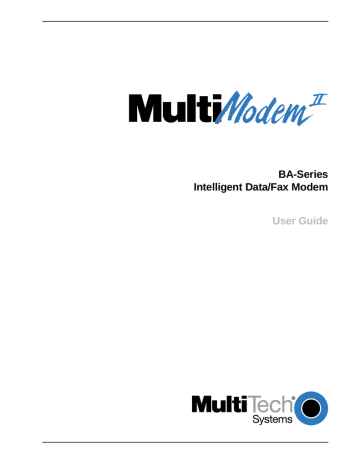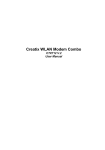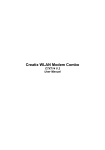Dial Modifier Commands. Multitech MT1432BA, MT2834BAI, MT2834BA
Add to my manuals
166 Pages
Multitech MT1432BA is an intelligent data/fax modem that provides reliable and efficient communication capabilities for your computer. With its advanced features, this modem is ideal for both home and office use. This modem is designed to offer a seamless and feature-rich communication experience, allowing you to connect with other devices, transfer data, and send and receive faxes with ease.
advertisement

MultiModemBA User Guide
To activate DTR Dialing, enter AT$D1 and hit RETURN. The modem dials the phone number stored in the N0 location of memory when it receives a high DTR signal. DTR must remain high for the duration of the call, until disconnect. To deactivate DTR dialing, enter AT$D0 and hit RETURN.
Note when using DTR Dialing in a synchronous application, be sure DIP-Switch #8 is in the UP position to disable V.25bis Command mode.
Voice/Data Dialing $VD
Another alternate method of causing the modem to automatically dial is Voice/Data Dialing. With
Voice/Data Dialing, the modem automatically dials the phone number stored in the N1 position of memory whenever the Voice/Data switch is toggled. You must first enter AT$VD1&W0<CR>. This command string enables Voice/Data dialing when the Voice/Data toggle switch is activated. To disable Voice/Data Dialing (default), enter the command AT$VD0 W0<CR>.
5.4.2
Dial Modifier Commands
There are several command characters that can be included within a dialing command (following the letter D), called “Dial Modifiers”. They have various functions, including the selection of Pulse or Tone
Dialing, pauses in the dial sequence, automatic re-dials if a number is busy, and reverting to the
Command mode or switching to the Answer mode after dialing.
Pulse or Tone Dial P T
The modem dials numbers using either pulse or tone dialing, or a combination of both methods.
Pulse dialing is a method used by rotary-dial telephones, which involves the timed opening and closing of line relay.
Tone dialing is the method used by push-button (touch tone) telephones, and is sometimes referred to as DTMF, or Dual-Tone Multi-Frequency dialing.
The method used is selected by including a P for Pulse or a T for Tone in the dialing command, right before the digits you wish to have dialed in that manner.
For example, you would pulse-dial the number 555-1212 by entering ATDP5551212 and hitting
RETURN. You could tone-dial the same number by entering ATDT5551212 and hitting RETURN. If neither Pulse nor Tone dialing is specified in the dial command, the modem uses whatever method used last. If the modem has been reset or just powered up, it uses Pulse dialing, even if the letter P is not included in your dial command.
Nearly all telephone systems in the U.S. are now compatible with tone dialing. Since that is the faster method, you will probably choose the tone method for your dialing.
An example of combining pulse and tone dialing could involve a PBX system where 9 had to be pulse-dialed first, then the rest of the number tone-dialed after pausing for a second dial tone. The number would be dialed by entering ATDP9, T5551212 and RETURN. (The comma causes a pause, which we’ll explain soon.)
Set Pulse Dial Ratios &P
This command sets the time ratios between the open and closed portions of the dialing pulse frequencies. To set the dialing pulse ratio of 60 mSec to 40 mSec, enter AT&P0. To set a ratio of 67 mSec to 33 mSec, enter AT&P1. The factory default is &P0.
50
Chapter 5 - Command Mode
Automatic Pauses in Dialing ,
You can cause the modem to pause during the dialing sequence by entering a comma character where the pause is desired. This pause lasts two seconds. If a longer pause is desired, more than one comma may be entered consecutively, with each comma causing a two second pause. You also have the option of changing the length of the pause caused by the comma, from two seconds to any other value from 0 up to 255 seconds. This is done by setting S-Register S8 (refer to
).
Each comma in a dialing command counts as one of the sixty allowed characters.
Long Space Disconnect Y
When two modems are connected in Normal mode (i.e. without error correction) there is no "polite" means of requesting a disconnect. A link disconnect request packet is sent under reliable connections. As a result some "garbage" may be received when a hang-up command is issued. The
Y1 command enables the modem to use the break signal which accomplishes the hang-up as an instruction to shut off its receiver and disconnect (both modems must have Y1 enabled for this feature to be effective). Y0 (factory default) disables this function.
Wait for New Dial-Tone W
A W inserted in the dialing command causes the modem to wait for another dial tone, and not resume dialing until another dial tone is detected.
It is not necessary to enter a W at the beginning of the dialing command to wait for a modem dial tone, because the modem will do that first (pause automatically).
In order for this command to work, you must select Wait-For-Dial Tone dialing with the X2 or X4 command, so that your modem will be able to detect the dial tone.
Return to Command Mode After Dial Command Execution ;
A semicolon (;), entered as the last character of a dialing command causes the modem to return to the Command mode immediately after executing the command, instead of waiting for a carrier signal and going on line.
For example, entering ATDT5551212; would tone-dial the number, and do nothing afterwards except go back into Command mode. This can be useful in dialing applications where modem data transfer is not desired, such as voice communications, or in applications involving the use of touch tones as a data entry method, such as bank-by-phone.
Reverse the Mode of Operation R
In certain operations you may need to reverse the mode of operation for your modem from originate to answer or answer to originate so that it would answer the phone and go into answer mode. This command turns off the reversing function with the R0 command and turns it on with the R1 command with the modem in either command mode. If you want to reverse from the originate mode, use R (with no number) in the dialing string.
Flash On Hook !
Some switchboard systems react to a momentary On Hook. An exclamation mark inserted in the command causes the modem to “flash” on hook for a half of a second, as if you had held the switch hook button on a telephone down for a half second.
For example, to flash On Hook after dialing the number 555-1234 in order to transfer to Extension
#5678, you might enter ATDT5551234,,!5678. The commas cause a 4 second pause (just to be safe).
51
MultiModemBA User Guide
"Calling Card" Detect Tones $
The modem has the capability to detect AT&T "calling card" tones for the purpose of utilizing the user's calling card number to originate an on-line connection. An $ symbol placed in the dialing string causes the modem to pause and wait for an AT&T "calling card" or a 1600 Hz tone (prevalent in the
United Kingdom). When the tone is detected, the rest of the dialing string is processed. If no tones are detected within the time period set by S-Register S7 (default 45 seconds), the modem will abort by indicating a NO CARRIER message. Hitting any key also aborts the $ command.
The following is an example of this command:
ATDT
1028806127853500
$
123456789
(access/phone number) (credit card number)
Quiet Answer @
The @ command causes the modem to wait before processing the next symbol in the dialing string.
The wait is for one or more ringbacks followed by 5 seconds of silence. If the time specified by S-
Register S7 passes before the rings and silence, a NO ANSWER (R) result code is processed. The
@ command is used for accessing a system that does not provide a dial tone.
For example, ATDT5551212@6313550 causes the modem to dial the first number (555-1212) and wait for the time specified in S7 for at least one ringback and 5 seconds of silence. If a busy signal is detected, the modem hangs up and generates a BUSY result code. If it does not detect 5 seconds of silence, a NO ANSWER result code is generated after hanging up. If 5 seconds of silence is detected, the second number (631-3550) is then dialed.
52
advertisement
* Your assessment is very important for improving the workof artificial intelligence, which forms the content of this project
Key Features
- Send and receive faxes: The MT1432BA allows you to send and receive faxes directly from your computer, eliminating the need for a separate fax machine.
- High-speed data transfer: With support for speeds up to 14.4 Kbps, the MT1432BA enables fast and efficient data transfer, making it suitable for downloading files, browsing the internet, and more.
- Caller ID: The modem supports Caller ID, allowing you to identify incoming callers and decide whether to answer or not.
- Voice mail: The MT1432BA can be used as a voice mail system, allowing you to receive and manage voice messages from callers.
- Error correction: The modem employs error correction techniques to ensure reliable data transmission, minimizing errors and ensuring data integrity.
Related manuals
Frequently Answers and Questions
How do I connect the MT1432BA to my computer?
What software is compatible with the MT1432BA?
How do I troubleshoot connection issues with the MT1432BA?
advertisement
Table of contents
- 8 Introduction
- 8 How To Use This Manual
- 10 Modem Features
- 10 2834 Series Features
- 10 1432 Series Features
- 10 932 Series Features
- 11 Fax Features
- 12 Technical Specifications
- 16 Power
- 16 Modem LED Indicators
- 17 Controls on PC Board
- 20 What is in Your Modem Package?
- 21 Installation
- 21 Safety Warnings
- 21 Installation Procedure
- 23 Loading Trio DataFAX Software
- 25 Is Your Modem Ready for Use?
- 28 Introduction
- 28 Serial Port Limitations
- 28 How Can You Identify Your UART Type?
- 29 The 16550 UART and Windows
- 29 Configuring Your Software
- 29 ConfiguringSoftware for Your Modem
- 30 PC Initialization Strings
- 30 Changing Default Parameters
- 30 Other Parameters
- 31 Macintosh Initialization
- 31 Configuring Software for Your Computer
- 31 Configuring Software for the Remote System
- 31 Terminal Emulation
- 32 File Transfer Protocols
- 32 When to Disable Data Compression
- 32 Disabling Error Correction
- 33 Modem Basics
- 33 Simple Operations
- 33 The Answer/Originate - Voice/Data Toggle Switch
- 36 Introduction
- 36 Dialing/On-Line/Answering
- 37 Manual Call Origination
- 37 Automatic Answering
- 38 Manual Answering
- 38 Handshaking Details
- 39 Call Termination
- 42 Introduction
- 42 AT Command Editing
- 43 Functional Modes
- 44 Summary of AT Commands
- 47 Result Codes
- 49 Dialing Commands
- 49 Dialing Action Commands
- 50 Dial Modifier Commands
- 53 Phone Number Memory Commands
- 54 Configuration and Default Storage Commands
- 56 Command Response (Result Code) Commands
- 58 Phone Line Conditioning Commands
- 61 RS-232C Interface Control Commands
- 63 Error Correction Commands
- 66 Flow Control Commands
- 69 5.4.10 Compression, Error Correction, Flow Control, Pass-Through and Pacing Commands
- 70 5.4.11 Speed Conversion Commands
- 73 5.4.12 Immediate Action Commands
- 75 5.4.13 Line Probe Commands (2834 Series only)
- 78 Introduction
- 84 Reading and Assigning S-Register Values
- 84 Examples of Assigning Values
- 84 Examples of Reading Values
- 85 AT Command and S-Register Summary
- 88 Introduction
- 88 Callback Feature Description
- 89 Remote Configuration Description
- 89 Initial Setup Procedures for Callback and Remote Configuration
- 92 Remote Configuration Procedures
- 93 Remote Configuration and Callback Security AT Commands
- 95 Remote Configuration/Callback Security S-Registers
- 98 Introduction
- 99 Local Analog Loopback Test/V.54 Loop
- 100 Digital Loopback Test/V.54 Loop 2 (Local/Manual)
- 101 Digital Loopback Test/V.54 Loop 2 (Remote/Automatic)
- 102 Back-to-Back Test
- 103 Synchronous Mode Testing
- 103 Local Analog Loopback Test (Synchronous Mode)
- 104 Digital Loopback Test (Local/Manual) (Synchronous Mode)
- 105 Digital Loopback Test (Remote/Automatic) (Synchronous Mode)
- 108 Introduction
- 109 DIP-Switch Option Settings
- 115 Speaker Volume Control
- 115 Recording Option Configurations
- 118 Introduction
- 118 Limited Warranty
- 118 10.2.1 On-line Warranty Registration
- 119 Tech Support
- 119 10.3.1 Recording Modem Information
- 119 Service
- 120 The Multi-Tech BBS
- 121 10.5.2 Upgrading the MultiModem
- 121 10.5.3 Using FlashPro to Upgrade Modem Firmware
- 121 About Multi-Tech’s Internet Presence
- 121 About the Multi-Tech Fax-Back Service
- 122 About Ordering Accessories
- 124 Appendix A - Troubleshooting
- 129 Appendix B - ASCII Character Code/Hex/Decimal Conversion Chart
- 130 Appendix C - Dial Pulse and Tone-Dial Frequencies
- 131 Appendix D - Command Summary
- 140 Appendix E - DIP-Switch Summary
- 143 Appendix F - S-Register Summary
- 145 Appendix G - Result Code Summary
- 147 Appendix H - V.25bis Operation
- 154 Appendix I - MultiModemBA Cables
- 156 Appendix J - RS-232C Interface Specifications
- 160 Appendix K - Regulatory Information


